
“Linking water,
science, and people”

Volunteer
Sierra Streams Institute welcomes volunteers of all ages and backgrounds with an
interest in our work and a desire to participate. Recruiting young people through
school and community service helps promote interest in scientific study while
furthering our work. Volunteers are thoroughly trained and paired with
experienced staff members for all projects and regular monitoring activities, both in the
field and in the lab.
Volunteer sign-up
Our award-winning water quality monitoring program is a citizen-based effort, based almost entirely on volunteer labor.
Monitoring opportunities are available at several sites in the Deer Creek watershed. Sites are located throughout Nevada County,
with sampling locations in and around Nevada City, Rough and Ready, Penn Valley, and Lake Wildwood.
Monitoring takes place during the second week of the month and requires a commitment of 1-2 hours per month.
In June and October volunteers assist with collecting macroinvertebrates (creek bugs) from their monitoring sites.
No experience needed—training will be provided.
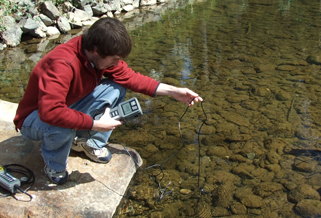
Justin Wood sampling dissolved oxygen and conductivity
at a site in Nevada City. Photo by Sol Henson.
You can help us process macroinvertebrate samples in our laboratory. This is a great
opportunity to obtain valuable lab and observation skills and learn a great deal about dichotomous keys and
invertebrate anatomy and zoology.
Volunteers use microscopes to count and identify macroinvertebrates in the lab.
Macroinvertebrate sessions occur every Wednesday morning from 8 to 12,
and on the 2nd and 4th Wednesday evening of each month from 5 to 8.
Join our volunteer bug expert Sandy Williamson and others in the lab and learn about
these cool creek critters! No experience needed--training will be provided.
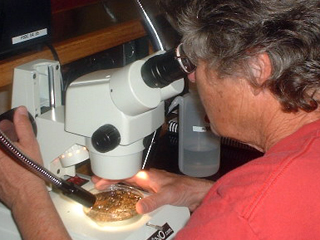
Identifying benthic macroinvertebrates in our "macro" lab.
Photo by Sandy Williamson.
Sierra Streams Institute and American Rivers are constructing a nine-mile loop trail, the
Deer Creek Tribute Trail,
along Deer Creek in Nevada County. You can help build this important means of accessing and enjoying Deer Creek.
The trail runs from the Newtown Canal ditch down to Deer Creek at Stocking Flat.
Contact the Tribute Trail coordinator for upcoming work dates.
Equipment and tools will be provided, but dont hesitate to bring your own.
Bring water, snacks, work gloves.
Wear long pants and closed-toed shoes.
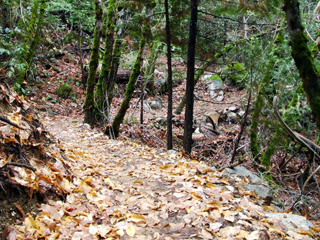
Photo by Matt Freitas.
Help us remove English Ivy, Himalayan Blackberry, and other non-native plants from Deer Creek's
riparian corridor and re-plant these areas with native vegetation. Restoration projects may also
involve trail construction, bank armoring, and various forms of erosion control. Volunteers will
be able to assist with trail construction, invasive plant removal, and native seed or plant
planting. If you are interested in these volunteer efforts, please
contact our Restoration Ecologist.
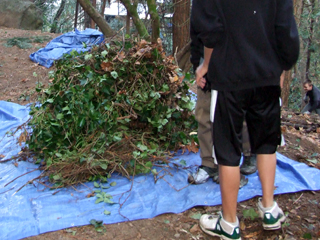
Ivy removal during Restoration Day on December 5, 2009..
Photo by Matt Freitas.
Get out in the field at random hours and see some amazing stream flows!
The goal of our storm water sampling project is to collect samples during the times of high stream flow that result from rain and snowmelt events.
Samples are collected for water quality, suspended solids, and mercury analysis.
Volunteers will assist with sample collection at several sites in the Deer Creek watershed.
Sites are concentrated around Nevada City and Lake Wildwood Reservoir.
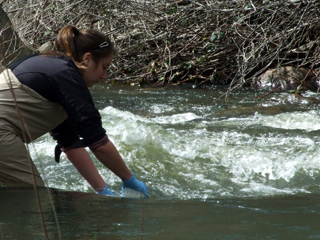
Storm water sampling in March, 2010. Photo by Justin Wood.
During three weeks in June, and then again in October, we collect benthic macroinvertebrates
and algae and then perform physical habitat assessments. All this field work requires many volunteers.
You get to play in the creek, collect bugs and slimy algae, and learn about hydrology, geomorphology, and river ecology.
Visit our Stream Science page for examples of the kinds of data you can help generate, as well
as information on why these are important activities.
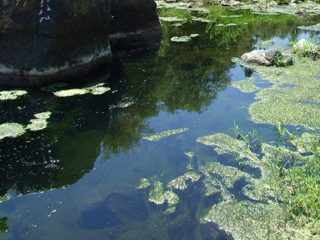
Algal growth in the creek. Photo by Justin Wood.









